Advanced Healthcare Software: FHIR Evaluation in Electronic HIE
VerifiedAdded on 2022/11/30
|22
|6280
|331
Report
AI Summary
This report critically examines the Fast Healthcare Interoperability Resources (FHIR) standard within the context of electronic healthcare information exchange (e-HIE). It begins by outlining the current landscape of e-HIE, discussing its benefits, classifications, and the models currently in use, while also addressing the challenges such as data privacy and security. The report then delves into the specifics of FHIR technology, detailing its components and applications, and its role in health IT. The core of the analysis involves a critical evaluation of FHIR's suitability in meeting both present and future system integration challenges in healthcare, highlighting its advantages and potential future challenges. The report concludes with a reflection on the knowledge gained during the research process, providing a comprehensive overview of FHIR's significance in advancing healthcare interoperability and patient care.
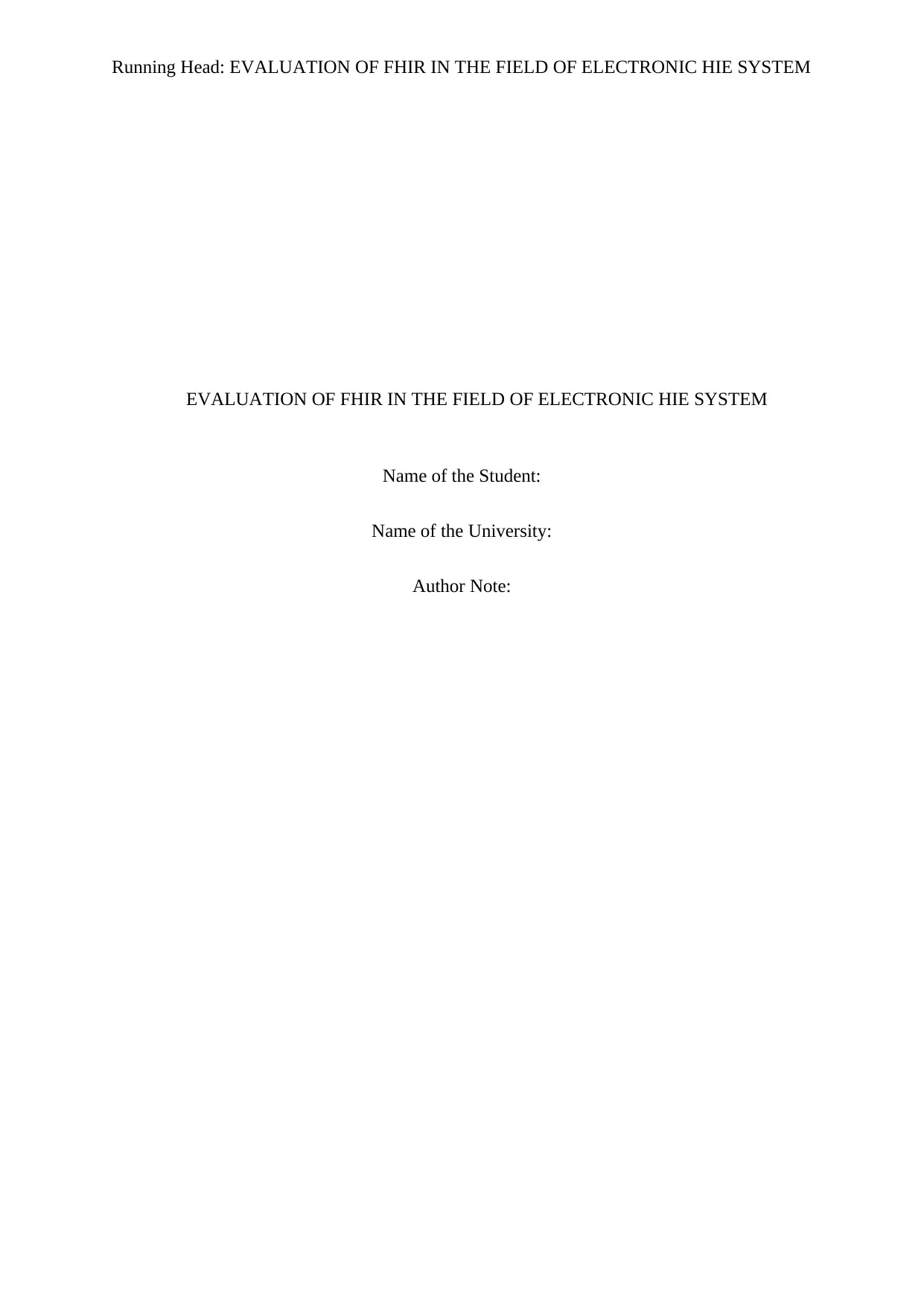
Running Head: EVALUATION OF FHIR IN THE FIELD OF ELECTRONIC HIE SYSTEM
EVALUATION OF FHIR IN THE FIELD OF ELECTRONIC HIE SYSTEM
Name of the Student:
Name of the University:
Author Note:
EVALUATION OF FHIR IN THE FIELD OF ELECTRONIC HIE SYSTEM
Name of the Student:
Name of the University:
Author Note:
Paraphrase This Document
Need a fresh take? Get an instant paraphrase of this document with our AI Paraphraser
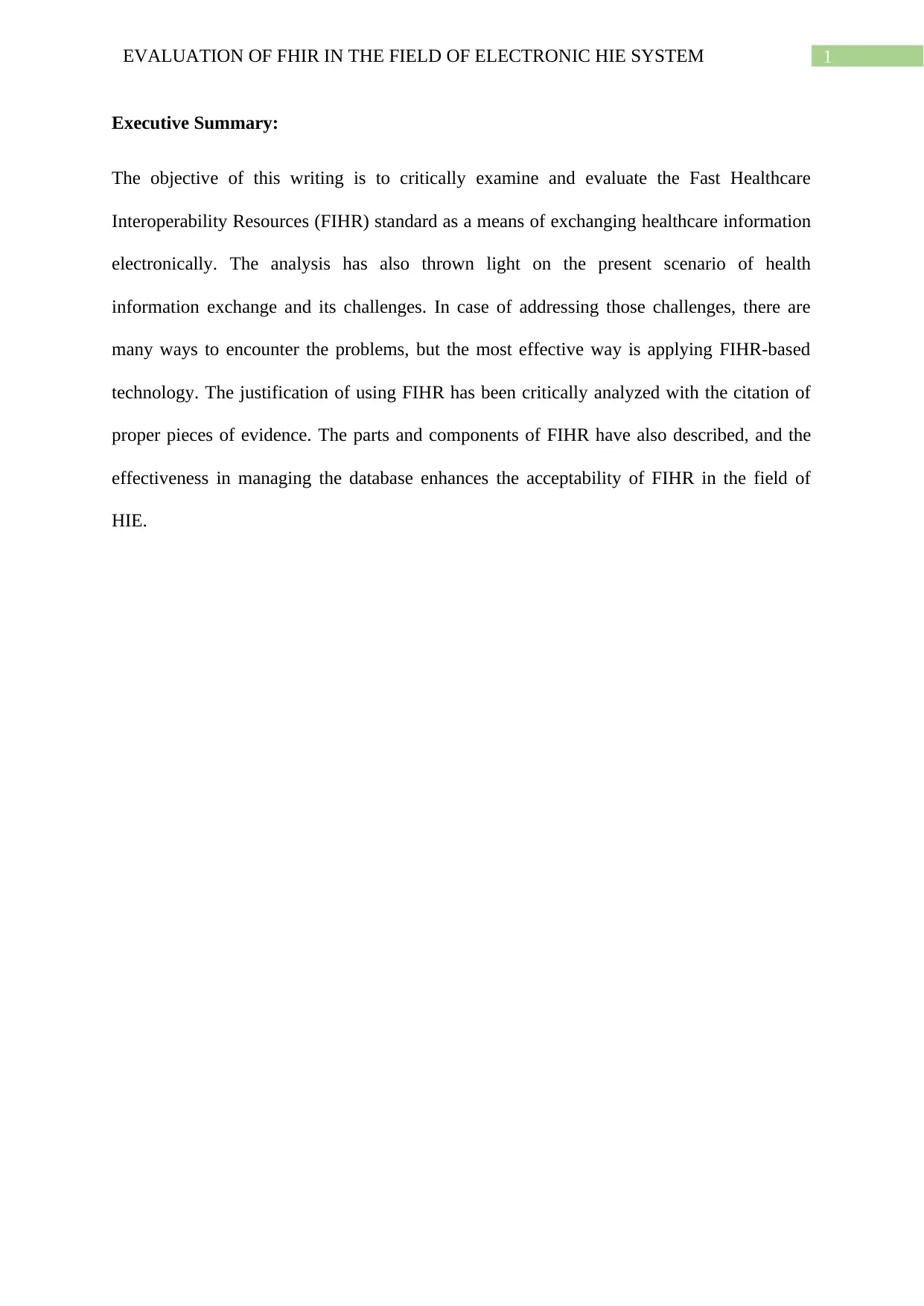
1EVALUATION OF FHIR IN THE FIELD OF ELECTRONIC HIE SYSTEM
Executive Summary:
The objective of this writing is to critically examine and evaluate the Fast Healthcare
Interoperability Resources (FIHR) standard as a means of exchanging healthcare information
electronically. The analysis has also thrown light on the present scenario of health
information exchange and its challenges. In case of addressing those challenges, there are
many ways to encounter the problems, but the most effective way is applying FIHR-based
technology. The justification of using FIHR has been critically analyzed with the citation of
proper pieces of evidence. The parts and components of FIHR have also described, and the
effectiveness in managing the database enhances the acceptability of FIHR in the field of
HIE.
Executive Summary:
The objective of this writing is to critically examine and evaluate the Fast Healthcare
Interoperability Resources (FIHR) standard as a means of exchanging healthcare information
electronically. The analysis has also thrown light on the present scenario of health
information exchange and its challenges. In case of addressing those challenges, there are
many ways to encounter the problems, but the most effective way is applying FIHR-based
technology. The justification of using FIHR has been critically analyzed with the citation of
proper pieces of evidence. The parts and components of FIHR have also described, and the
effectiveness in managing the database enhances the acceptability of FIHR in the field of
HIE.
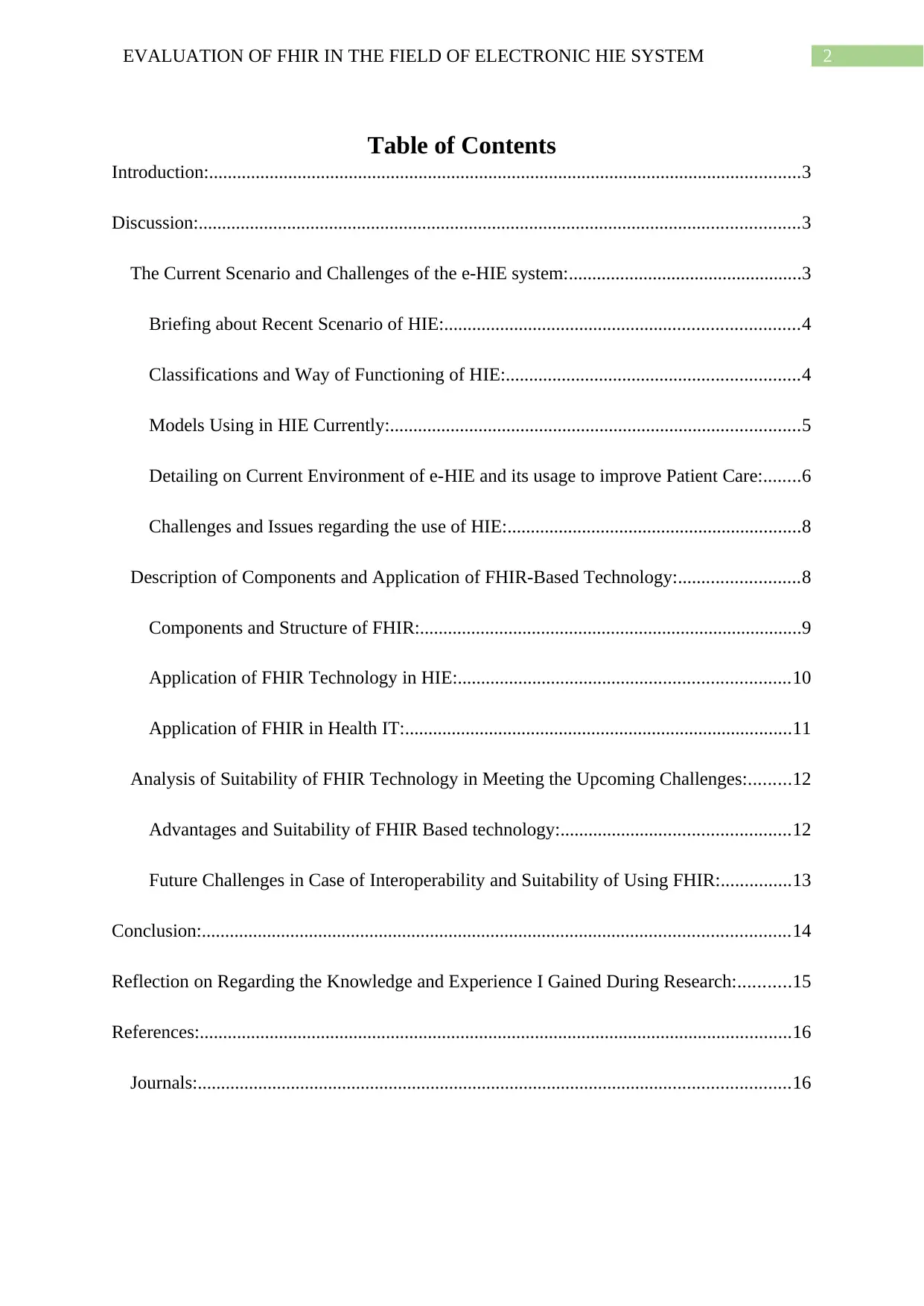
2EVALUATION OF FHIR IN THE FIELD OF ELECTRONIC HIE SYSTEM
Table of Contents
Introduction:...............................................................................................................................3
Discussion:.................................................................................................................................3
The Current Scenario and Challenges of the e-HIE system:..................................................3
Briefing about Recent Scenario of HIE:............................................................................4
Classifications and Way of Functioning of HIE:...............................................................4
Models Using in HIE Currently:........................................................................................5
Detailing on Current Environment of e-HIE and its usage to improve Patient Care:........6
Challenges and Issues regarding the use of HIE:...............................................................8
Description of Components and Application of FHIR-Based Technology:..........................8
Components and Structure of FHIR:..................................................................................9
Application of FHIR Technology in HIE:.......................................................................10
Application of FHIR in Health IT:...................................................................................11
Analysis of Suitability of FHIR Technology in Meeting the Upcoming Challenges:.........12
Advantages and Suitability of FHIR Based technology:.................................................12
Future Challenges in Case of Interoperability and Suitability of Using FHIR:...............13
Conclusion:..............................................................................................................................14
Reflection on Regarding the Knowledge and Experience I Gained During Research:...........15
References:...............................................................................................................................16
Journals:...............................................................................................................................16
Table of Contents
Introduction:...............................................................................................................................3
Discussion:.................................................................................................................................3
The Current Scenario and Challenges of the e-HIE system:..................................................3
Briefing about Recent Scenario of HIE:............................................................................4
Classifications and Way of Functioning of HIE:...............................................................4
Models Using in HIE Currently:........................................................................................5
Detailing on Current Environment of e-HIE and its usage to improve Patient Care:........6
Challenges and Issues regarding the use of HIE:...............................................................8
Description of Components and Application of FHIR-Based Technology:..........................8
Components and Structure of FHIR:..................................................................................9
Application of FHIR Technology in HIE:.......................................................................10
Application of FHIR in Health IT:...................................................................................11
Analysis of Suitability of FHIR Technology in Meeting the Upcoming Challenges:.........12
Advantages and Suitability of FHIR Based technology:.................................................12
Future Challenges in Case of Interoperability and Suitability of Using FHIR:...............13
Conclusion:..............................................................................................................................14
Reflection on Regarding the Knowledge and Experience I Gained During Research:...........15
References:...............................................................................................................................16
Journals:...............................................................................................................................16
⊘ This is a preview!⊘
Do you want full access?
Subscribe today to unlock all pages.

Trusted by 1+ million students worldwide
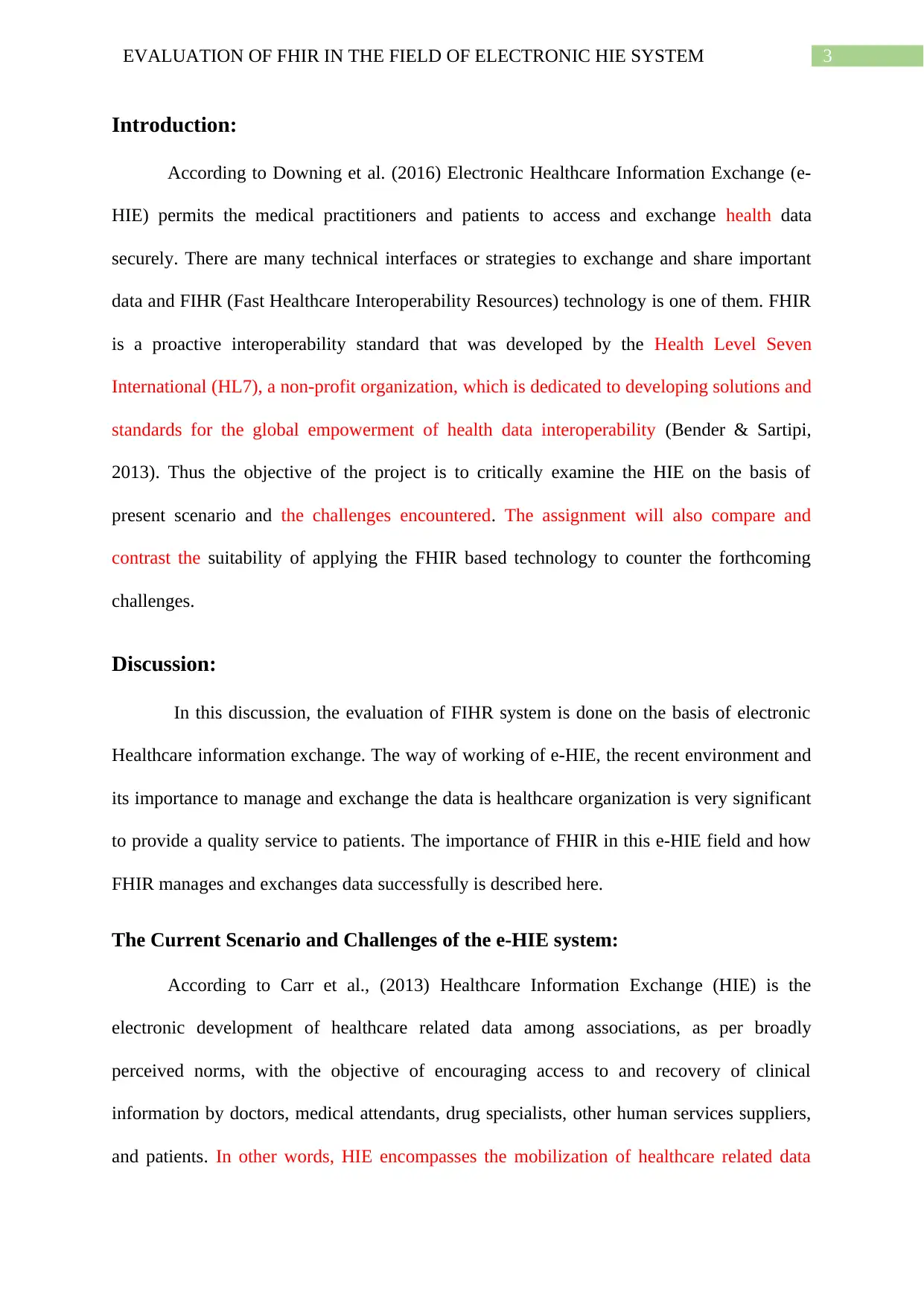
3EVALUATION OF FHIR IN THE FIELD OF ELECTRONIC HIE SYSTEM
Introduction:
According to Downing et al. (2016) Electronic Healthcare Information Exchange (e-
HIE) permits the medical practitioners and patients to access and exchange health data
securely. There are many technical interfaces or strategies to exchange and share important
data and FIHR (Fast Healthcare Interoperability Resources) technology is one of them. FHIR
is a proactive interoperability standard that was developed by the Health Level Seven
International (HL7), a non-profit organization, which is dedicated to developing solutions and
standards for the global empowerment of health data interoperability (Bender & Sartipi,
2013). Thus the objective of the project is to critically examine the HIE on the basis of
present scenario and the challenges encountered. The assignment will also compare and
contrast the suitability of applying the FHIR based technology to counter the forthcoming
challenges.
Discussion:
In this discussion, the evaluation of FIHR system is done on the basis of electronic
Healthcare information exchange. The way of working of e-HIE, the recent environment and
its importance to manage and exchange the data is healthcare organization is very significant
to provide a quality service to patients. The importance of FHIR in this e-HIE field and how
FHIR manages and exchanges data successfully is described here.
The Current Scenario and Challenges of the e-HIE system:
According to Carr et al., (2013) Healthcare Information Exchange (HIE) is the
electronic development of healthcare related data among associations, as per broadly
perceived norms, with the objective of encouraging access to and recovery of clinical
information by doctors, medical attendants, drug specialists, other human services suppliers,
and patients. In other words, HIE encompasses the mobilization of healthcare related data
Introduction:
According to Downing et al. (2016) Electronic Healthcare Information Exchange (e-
HIE) permits the medical practitioners and patients to access and exchange health data
securely. There are many technical interfaces or strategies to exchange and share important
data and FIHR (Fast Healthcare Interoperability Resources) technology is one of them. FHIR
is a proactive interoperability standard that was developed by the Health Level Seven
International (HL7), a non-profit organization, which is dedicated to developing solutions and
standards for the global empowerment of health data interoperability (Bender & Sartipi,
2013). Thus the objective of the project is to critically examine the HIE on the basis of
present scenario and the challenges encountered. The assignment will also compare and
contrast the suitability of applying the FHIR based technology to counter the forthcoming
challenges.
Discussion:
In this discussion, the evaluation of FIHR system is done on the basis of electronic
Healthcare information exchange. The way of working of e-HIE, the recent environment and
its importance to manage and exchange the data is healthcare organization is very significant
to provide a quality service to patients. The importance of FHIR in this e-HIE field and how
FHIR manages and exchanges data successfully is described here.
The Current Scenario and Challenges of the e-HIE system:
According to Carr et al., (2013) Healthcare Information Exchange (HIE) is the
electronic development of healthcare related data among associations, as per broadly
perceived norms, with the objective of encouraging access to and recovery of clinical
information by doctors, medical attendants, drug specialists, other human services suppliers,
and patients. In other words, HIE encompasses the mobilization of healthcare related data
Paraphrase This Document
Need a fresh take? Get an instant paraphrase of this document with our AI Paraphraser
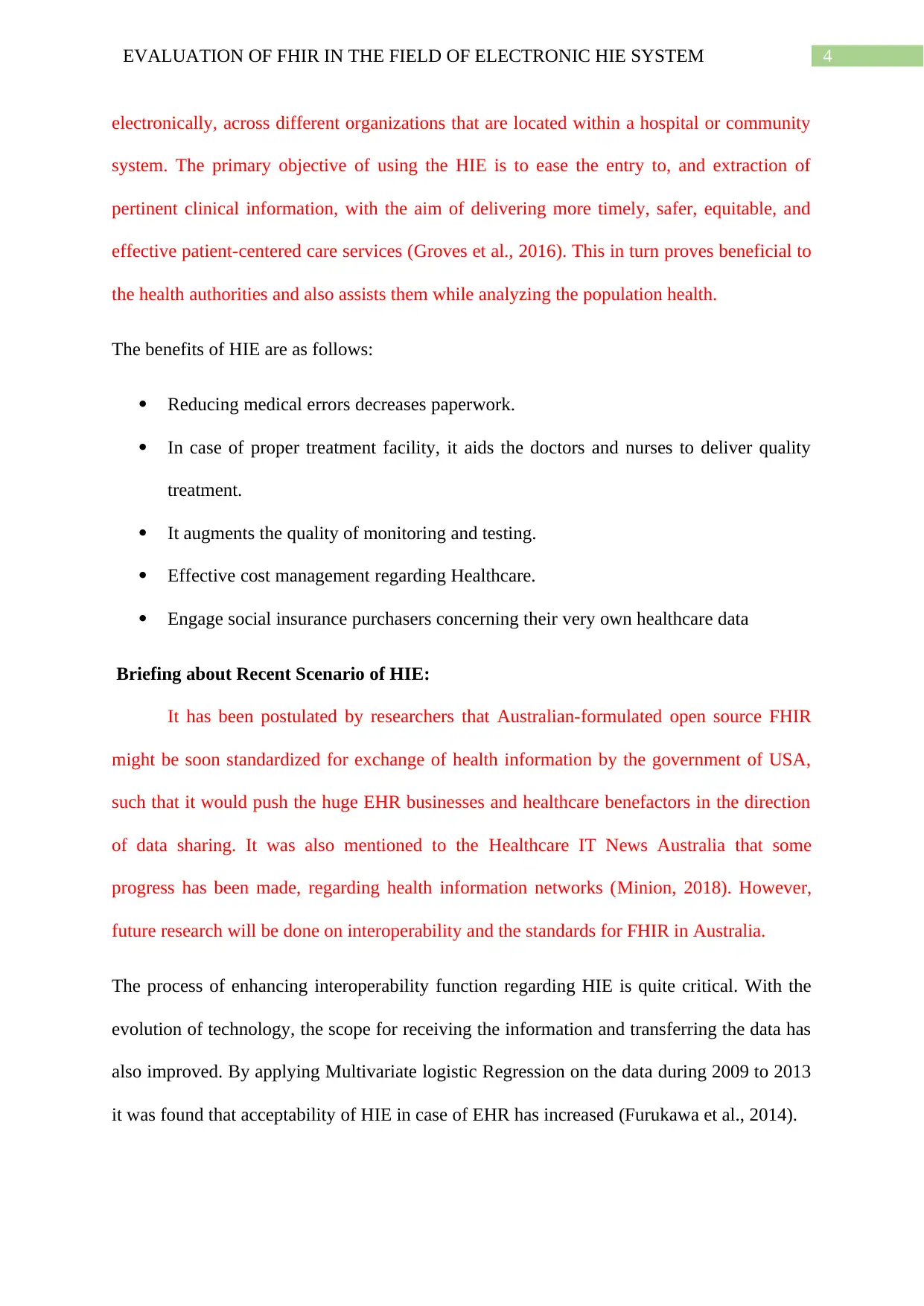
4EVALUATION OF FHIR IN THE FIELD OF ELECTRONIC HIE SYSTEM
electronically, across different organizations that are located within a hospital or community
system. The primary objective of using the HIE is to ease the entry to, and extraction of
pertinent clinical information, with the aim of delivering more timely, safer, equitable, and
effective patient-centered care services (Groves et al., 2016). This in turn proves beneficial to
the health authorities and also assists them while analyzing the population health.
The benefits of HIE are as follows:
Reducing medical errors decreases paperwork.
In case of proper treatment facility, it aids the doctors and nurses to deliver quality
treatment.
It augments the quality of monitoring and testing.
Effective cost management regarding Healthcare.
Engage social insurance purchasers concerning their very own healthcare data
Briefing about Recent Scenario of HIE:
It has been postulated by researchers that Australian-formulated open source FHIR
might be soon standardized for exchange of health information by the government of USA,
such that it would push the huge EHR businesses and healthcare benefactors in the direction
of data sharing. It was also mentioned to the Healthcare IT News Australia that some
progress has been made, regarding health information networks (Minion, 2018). However,
future research will be done on interoperability and the standards for FHIR in Australia.
The process of enhancing interoperability function regarding HIE is quite critical. With the
evolution of technology, the scope for receiving the information and transferring the data has
also improved. By applying Multivariate logistic Regression on the data during 2009 to 2013
it was found that acceptability of HIE in case of EHR has increased (Furukawa et al., 2014).
electronically, across different organizations that are located within a hospital or community
system. The primary objective of using the HIE is to ease the entry to, and extraction of
pertinent clinical information, with the aim of delivering more timely, safer, equitable, and
effective patient-centered care services (Groves et al., 2016). This in turn proves beneficial to
the health authorities and also assists them while analyzing the population health.
The benefits of HIE are as follows:
Reducing medical errors decreases paperwork.
In case of proper treatment facility, it aids the doctors and nurses to deliver quality
treatment.
It augments the quality of monitoring and testing.
Effective cost management regarding Healthcare.
Engage social insurance purchasers concerning their very own healthcare data
Briefing about Recent Scenario of HIE:
It has been postulated by researchers that Australian-formulated open source FHIR
might be soon standardized for exchange of health information by the government of USA,
such that it would push the huge EHR businesses and healthcare benefactors in the direction
of data sharing. It was also mentioned to the Healthcare IT News Australia that some
progress has been made, regarding health information networks (Minion, 2018). However,
future research will be done on interoperability and the standards for FHIR in Australia.
The process of enhancing interoperability function regarding HIE is quite critical. With the
evolution of technology, the scope for receiving the information and transferring the data has
also improved. By applying Multivariate logistic Regression on the data during 2009 to 2013
it was found that acceptability of HIE in case of EHR has increased (Furukawa et al., 2014).
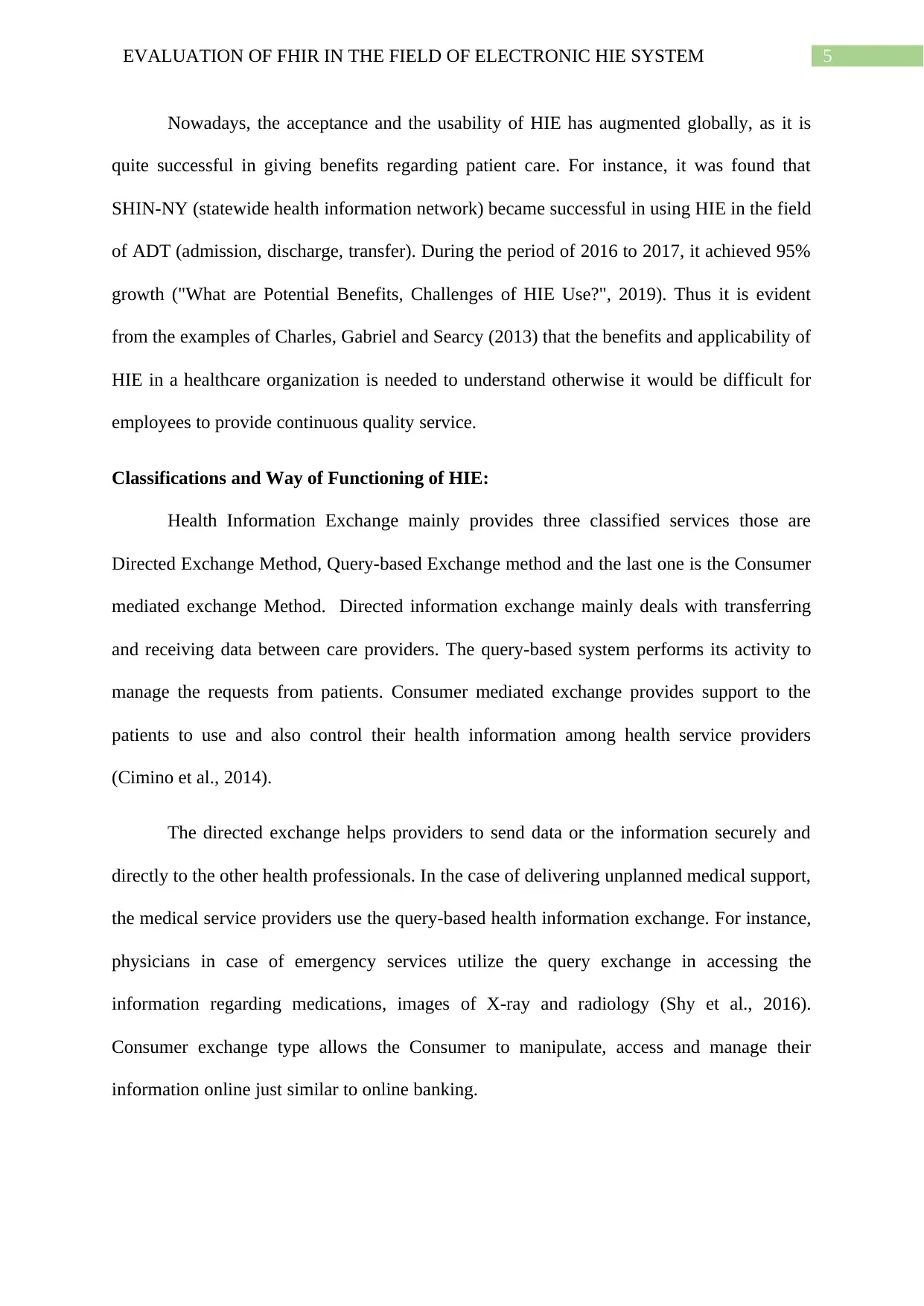
5EVALUATION OF FHIR IN THE FIELD OF ELECTRONIC HIE SYSTEM
Nowadays, the acceptance and the usability of HIE has augmented globally, as it is
quite successful in giving benefits regarding patient care. For instance, it was found that
SHIN-NY (statewide health information network) became successful in using HIE in the field
of ADT (admission, discharge, transfer). During the period of 2016 to 2017, it achieved 95%
growth ("What are Potential Benefits, Challenges of HIE Use?", 2019). Thus it is evident
from the examples of Charles, Gabriel and Searcy (2013) that the benefits and applicability of
HIE in a healthcare organization is needed to understand otherwise it would be difficult for
employees to provide continuous quality service.
Classifications and Way of Functioning of HIE:
Health Information Exchange mainly provides three classified services those are
Directed Exchange Method, Query-based Exchange method and the last one is the Consumer
mediated exchange Method. Directed information exchange mainly deals with transferring
and receiving data between care providers. The query-based system performs its activity to
manage the requests from patients. Consumer mediated exchange provides support to the
patients to use and also control their health information among health service providers
(Cimino et al., 2014).
The directed exchange helps providers to send data or the information securely and
directly to the other health professionals. In the case of delivering unplanned medical support,
the medical service providers use the query-based health information exchange. For instance,
physicians in case of emergency services utilize the query exchange in accessing the
information regarding medications, images of X-ray and radiology (Shy et al., 2016).
Consumer exchange type allows the Consumer to manipulate, access and manage their
information online just similar to online banking.
Nowadays, the acceptance and the usability of HIE has augmented globally, as it is
quite successful in giving benefits regarding patient care. For instance, it was found that
SHIN-NY (statewide health information network) became successful in using HIE in the field
of ADT (admission, discharge, transfer). During the period of 2016 to 2017, it achieved 95%
growth ("What are Potential Benefits, Challenges of HIE Use?", 2019). Thus it is evident
from the examples of Charles, Gabriel and Searcy (2013) that the benefits and applicability of
HIE in a healthcare organization is needed to understand otherwise it would be difficult for
employees to provide continuous quality service.
Classifications and Way of Functioning of HIE:
Health Information Exchange mainly provides three classified services those are
Directed Exchange Method, Query-based Exchange method and the last one is the Consumer
mediated exchange Method. Directed information exchange mainly deals with transferring
and receiving data between care providers. The query-based system performs its activity to
manage the requests from patients. Consumer mediated exchange provides support to the
patients to use and also control their health information among health service providers
(Cimino et al., 2014).
The directed exchange helps providers to send data or the information securely and
directly to the other health professionals. In the case of delivering unplanned medical support,
the medical service providers use the query-based health information exchange. For instance,
physicians in case of emergency services utilize the query exchange in accessing the
information regarding medications, images of X-ray and radiology (Shy et al., 2016).
Consumer exchange type allows the Consumer to manipulate, access and manage their
information online just similar to online banking.
⊘ This is a preview!⊘
Do you want full access?
Subscribe today to unlock all pages.

Trusted by 1+ million students worldwide
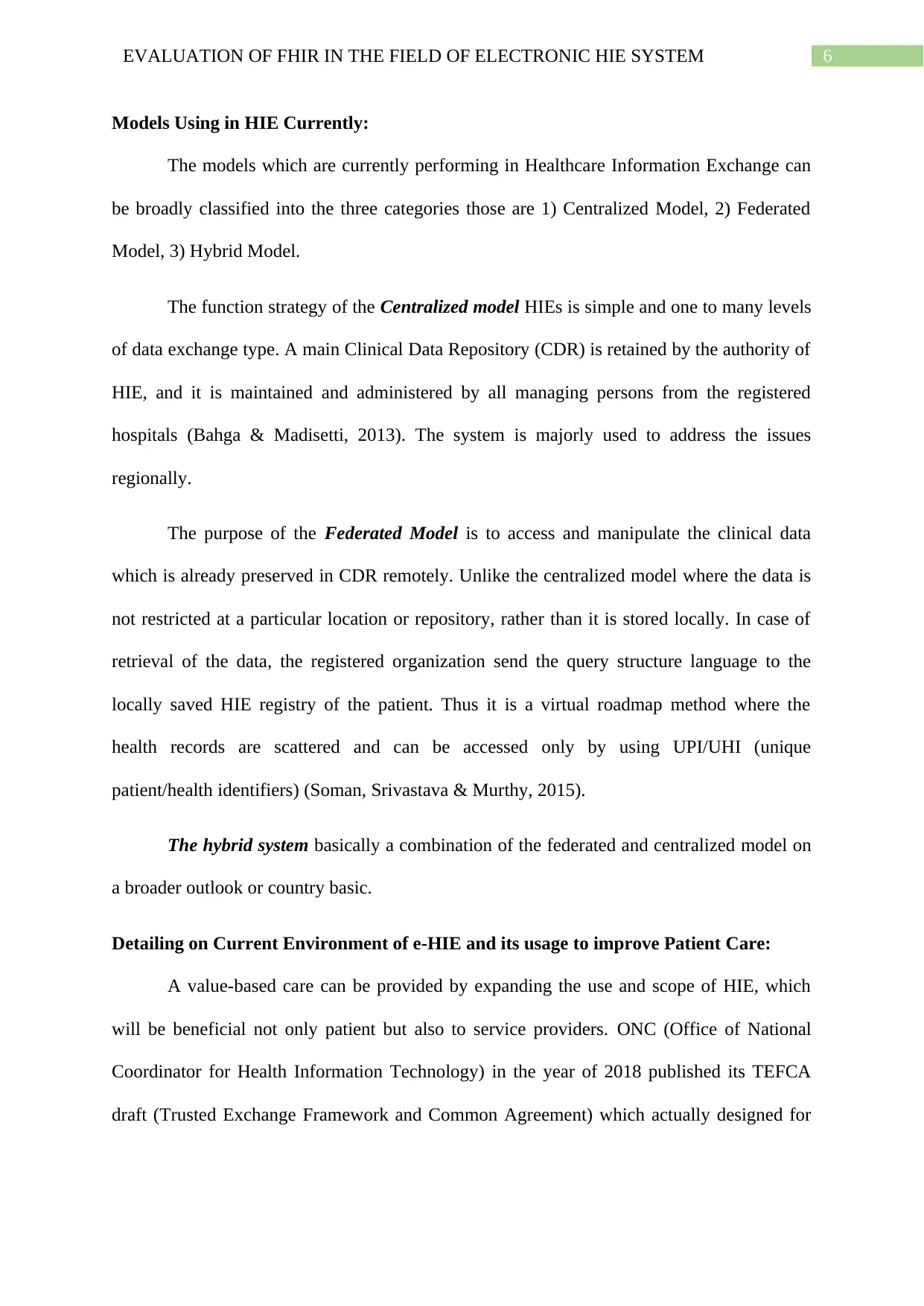
6EVALUATION OF FHIR IN THE FIELD OF ELECTRONIC HIE SYSTEM
Models Using in HIE Currently:
The models which are currently performing in Healthcare Information Exchange can
be broadly classified into the three categories those are 1) Centralized Model, 2) Federated
Model, 3) Hybrid Model.
The function strategy of the Centralized model HIEs is simple and one to many levels
of data exchange type. A main Clinical Data Repository (CDR) is retained by the authority of
HIE, and it is maintained and administered by all managing persons from the registered
hospitals (Bahga & Madisetti, 2013). The system is majorly used to address the issues
regionally.
The purpose of the Federated Model is to access and manipulate the clinical data
which is already preserved in CDR remotely. Unlike the centralized model where the data is
not restricted at a particular location or repository, rather than it is stored locally. In case of
retrieval of the data, the registered organization send the query structure language to the
locally saved HIE registry of the patient. Thus it is a virtual roadmap method where the
health records are scattered and can be accessed only by using UPI/UHI (unique
patient/health identifiers) (Soman, Srivastava & Murthy, 2015).
The hybrid system basically a combination of the federated and centralized model on
a broader outlook or country basic.
Detailing on Current Environment of e-HIE and its usage to improve Patient Care:
A value-based care can be provided by expanding the use and scope of HIE, which
will be beneficial not only patient but also to service providers. ONC (Office of National
Coordinator for Health Information Technology) in the year of 2018 published its TEFCA
draft (Trusted Exchange Framework and Common Agreement) which actually designed for
Models Using in HIE Currently:
The models which are currently performing in Healthcare Information Exchange can
be broadly classified into the three categories those are 1) Centralized Model, 2) Federated
Model, 3) Hybrid Model.
The function strategy of the Centralized model HIEs is simple and one to many levels
of data exchange type. A main Clinical Data Repository (CDR) is retained by the authority of
HIE, and it is maintained and administered by all managing persons from the registered
hospitals (Bahga & Madisetti, 2013). The system is majorly used to address the issues
regionally.
The purpose of the Federated Model is to access and manipulate the clinical data
which is already preserved in CDR remotely. Unlike the centralized model where the data is
not restricted at a particular location or repository, rather than it is stored locally. In case of
retrieval of the data, the registered organization send the query structure language to the
locally saved HIE registry of the patient. Thus it is a virtual roadmap method where the
health records are scattered and can be accessed only by using UPI/UHI (unique
patient/health identifiers) (Soman, Srivastava & Murthy, 2015).
The hybrid system basically a combination of the federated and centralized model on
a broader outlook or country basic.
Detailing on Current Environment of e-HIE and its usage to improve Patient Care:
A value-based care can be provided by expanding the use and scope of HIE, which
will be beneficial not only patient but also to service providers. ONC (Office of National
Coordinator for Health Information Technology) in the year of 2018 published its TEFCA
draft (Trusted Exchange Framework and Common Agreement) which actually designed for
Paraphrase This Document
Need a fresh take? Get an instant paraphrase of this document with our AI Paraphraser
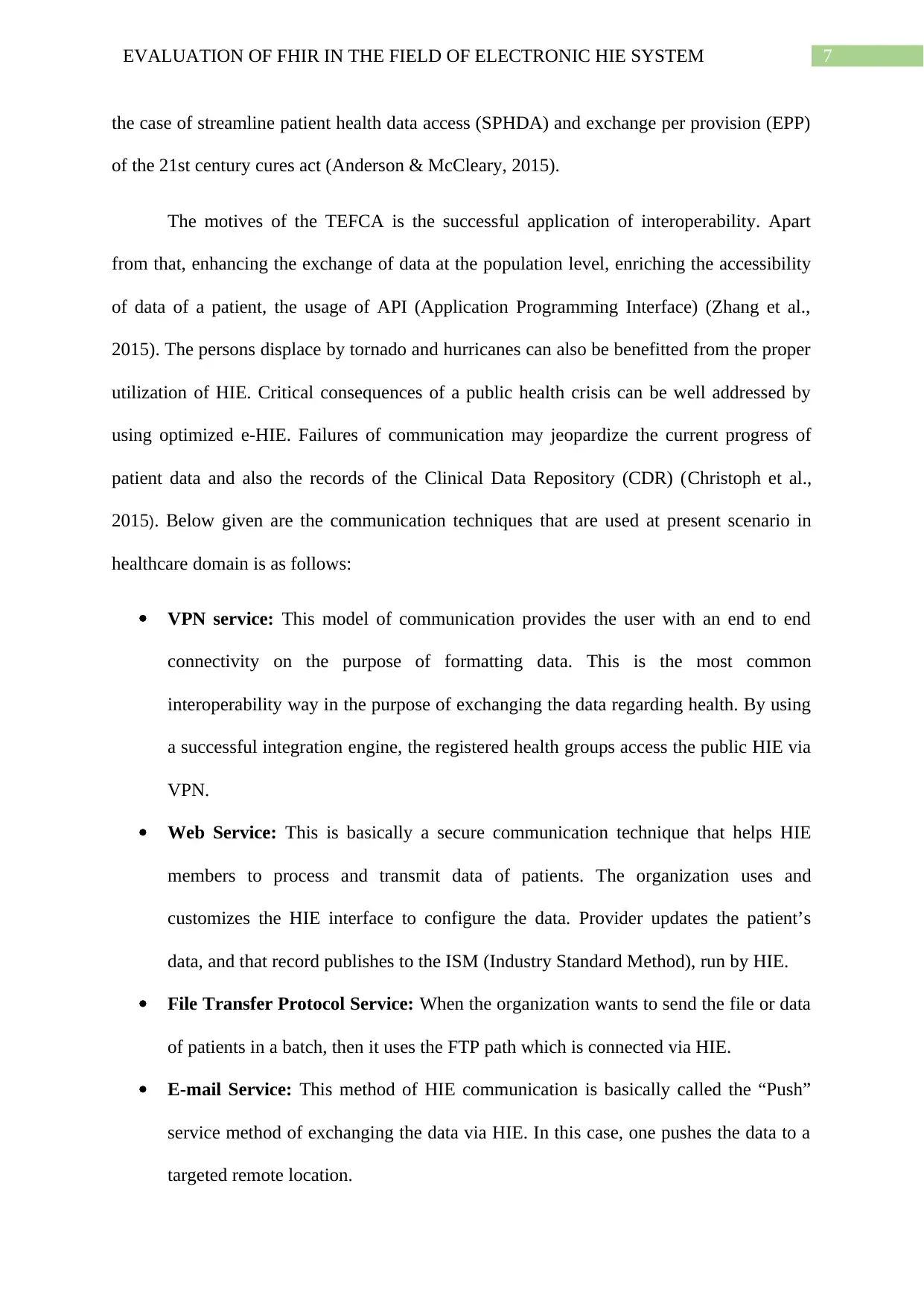
7EVALUATION OF FHIR IN THE FIELD OF ELECTRONIC HIE SYSTEM
the case of streamline patient health data access (SPHDA) and exchange per provision (EPP)
of the 21st century cures act (Anderson & McCleary, 2015).
The motives of the TEFCA is the successful application of interoperability. Apart
from that, enhancing the exchange of data at the population level, enriching the accessibility
of data of a patient, the usage of API (Application Programming Interface) (Zhang et al.,
2015). The persons displace by tornado and hurricanes can also be benefitted from the proper
utilization of HIE. Critical consequences of a public health crisis can be well addressed by
using optimized e-HIE. Failures of communication may jeopardize the current progress of
patient data and also the records of the Clinical Data Repository (CDR) (Christoph et al.,
2015). Below given are the communication techniques that are used at present scenario in
healthcare domain is as follows:
VPN service: This model of communication provides the user with an end to end
connectivity on the purpose of formatting data. This is the most common
interoperability way in the purpose of exchanging the data regarding health. By using
a successful integration engine, the registered health groups access the public HIE via
VPN.
Web Service: This is basically a secure communication technique that helps HIE
members to process and transmit data of patients. The organization uses and
customizes the HIE interface to configure the data. Provider updates the patient’s
data, and that record publishes to the ISM (Industry Standard Method), run by HIE.
File Transfer Protocol Service: When the organization wants to send the file or data
of patients in a batch, then it uses the FTP path which is connected via HIE.
E-mail Service: This method of HIE communication is basically called the “Push”
service method of exchanging the data via HIE. In this case, one pushes the data to a
targeted remote location.
the case of streamline patient health data access (SPHDA) and exchange per provision (EPP)
of the 21st century cures act (Anderson & McCleary, 2015).
The motives of the TEFCA is the successful application of interoperability. Apart
from that, enhancing the exchange of data at the population level, enriching the accessibility
of data of a patient, the usage of API (Application Programming Interface) (Zhang et al.,
2015). The persons displace by tornado and hurricanes can also be benefitted from the proper
utilization of HIE. Critical consequences of a public health crisis can be well addressed by
using optimized e-HIE. Failures of communication may jeopardize the current progress of
patient data and also the records of the Clinical Data Repository (CDR) (Christoph et al.,
2015). Below given are the communication techniques that are used at present scenario in
healthcare domain is as follows:
VPN service: This model of communication provides the user with an end to end
connectivity on the purpose of formatting data. This is the most common
interoperability way in the purpose of exchanging the data regarding health. By using
a successful integration engine, the registered health groups access the public HIE via
VPN.
Web Service: This is basically a secure communication technique that helps HIE
members to process and transmit data of patients. The organization uses and
customizes the HIE interface to configure the data. Provider updates the patient’s
data, and that record publishes to the ISM (Industry Standard Method), run by HIE.
File Transfer Protocol Service: When the organization wants to send the file or data
of patients in a batch, then it uses the FTP path which is connected via HIE.
E-mail Service: This method of HIE communication is basically called the “Push”
service method of exchanging the data via HIE. In this case, one pushes the data to a
targeted remote location.
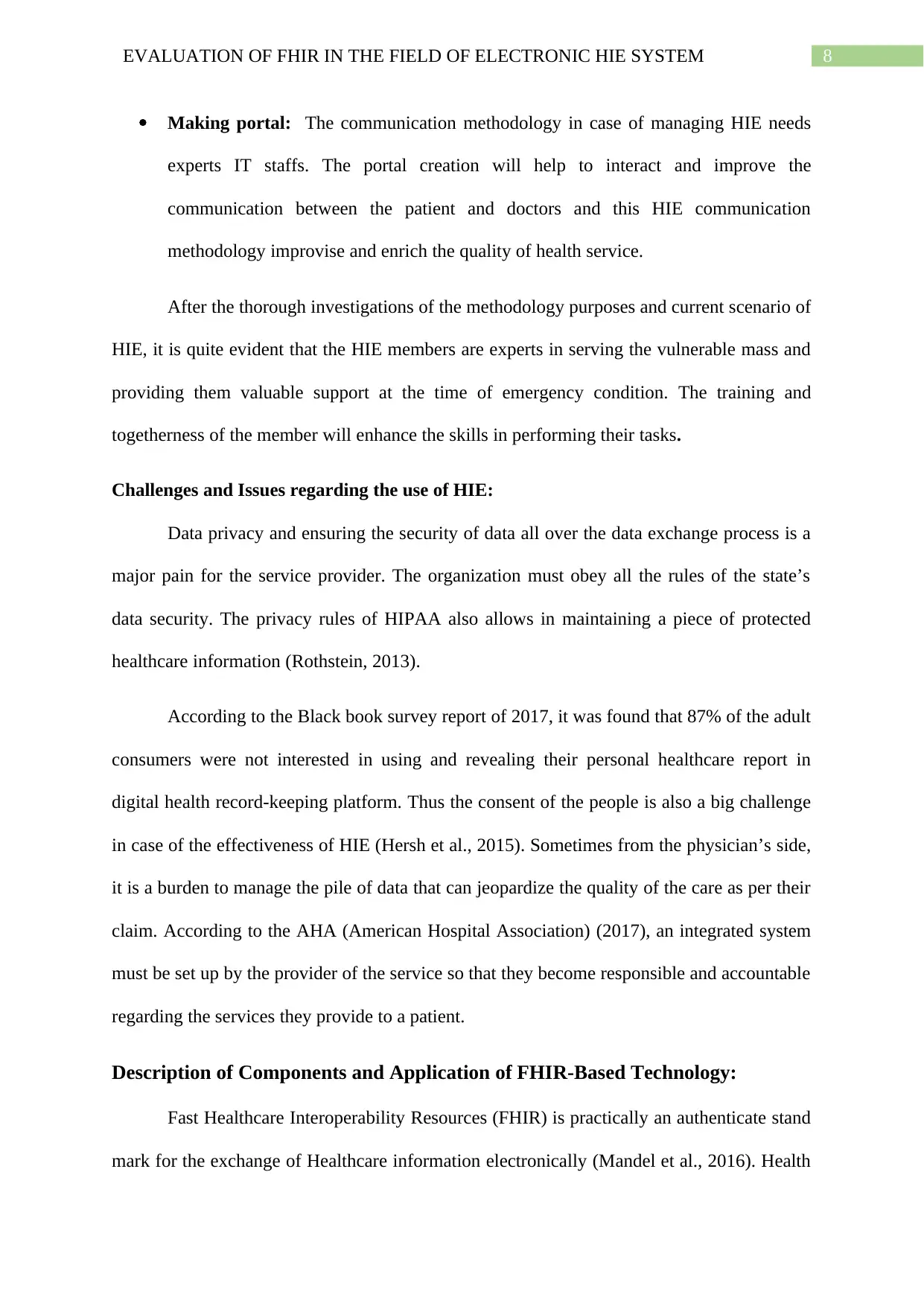
8EVALUATION OF FHIR IN THE FIELD OF ELECTRONIC HIE SYSTEM
Making portal: The communication methodology in case of managing HIE needs
experts IT staffs. The portal creation will help to interact and improve the
communication between the patient and doctors and this HIE communication
methodology improvise and enrich the quality of health service.
After the thorough investigations of the methodology purposes and current scenario of
HIE, it is quite evident that the HIE members are experts in serving the vulnerable mass and
providing them valuable support at the time of emergency condition. The training and
togetherness of the member will enhance the skills in performing their tasks.
Challenges and Issues regarding the use of HIE:
Data privacy and ensuring the security of data all over the data exchange process is a
major pain for the service provider. The organization must obey all the rules of the state’s
data security. The privacy rules of HIPAA also allows in maintaining a piece of protected
healthcare information (Rothstein, 2013).
According to the Black book survey report of 2017, it was found that 87% of the adult
consumers were not interested in using and revealing their personal healthcare report in
digital health record-keeping platform. Thus the consent of the people is also a big challenge
in case of the effectiveness of HIE (Hersh et al., 2015). Sometimes from the physician’s side,
it is a burden to manage the pile of data that can jeopardize the quality of the care as per their
claim. According to the AHA (American Hospital Association) (2017), an integrated system
must be set up by the provider of the service so that they become responsible and accountable
regarding the services they provide to a patient.
Description of Components and Application of FHIR-Based Technology:
Fast Healthcare Interoperability Resources (FHIR) is practically an authenticate stand
mark for the exchange of Healthcare information electronically (Mandel et al., 2016). Health
Making portal: The communication methodology in case of managing HIE needs
experts IT staffs. The portal creation will help to interact and improve the
communication between the patient and doctors and this HIE communication
methodology improvise and enrich the quality of health service.
After the thorough investigations of the methodology purposes and current scenario of
HIE, it is quite evident that the HIE members are experts in serving the vulnerable mass and
providing them valuable support at the time of emergency condition. The training and
togetherness of the member will enhance the skills in performing their tasks.
Challenges and Issues regarding the use of HIE:
Data privacy and ensuring the security of data all over the data exchange process is a
major pain for the service provider. The organization must obey all the rules of the state’s
data security. The privacy rules of HIPAA also allows in maintaining a piece of protected
healthcare information (Rothstein, 2013).
According to the Black book survey report of 2017, it was found that 87% of the adult
consumers were not interested in using and revealing their personal healthcare report in
digital health record-keeping platform. Thus the consent of the people is also a big challenge
in case of the effectiveness of HIE (Hersh et al., 2015). Sometimes from the physician’s side,
it is a burden to manage the pile of data that can jeopardize the quality of the care as per their
claim. According to the AHA (American Hospital Association) (2017), an integrated system
must be set up by the provider of the service so that they become responsible and accountable
regarding the services they provide to a patient.
Description of Components and Application of FHIR-Based Technology:
Fast Healthcare Interoperability Resources (FHIR) is practically an authenticate stand
mark for the exchange of Healthcare information electronically (Mandel et al., 2016). Health
⊘ This is a preview!⊘
Do you want full access?
Subscribe today to unlock all pages.

Trusted by 1+ million students worldwide
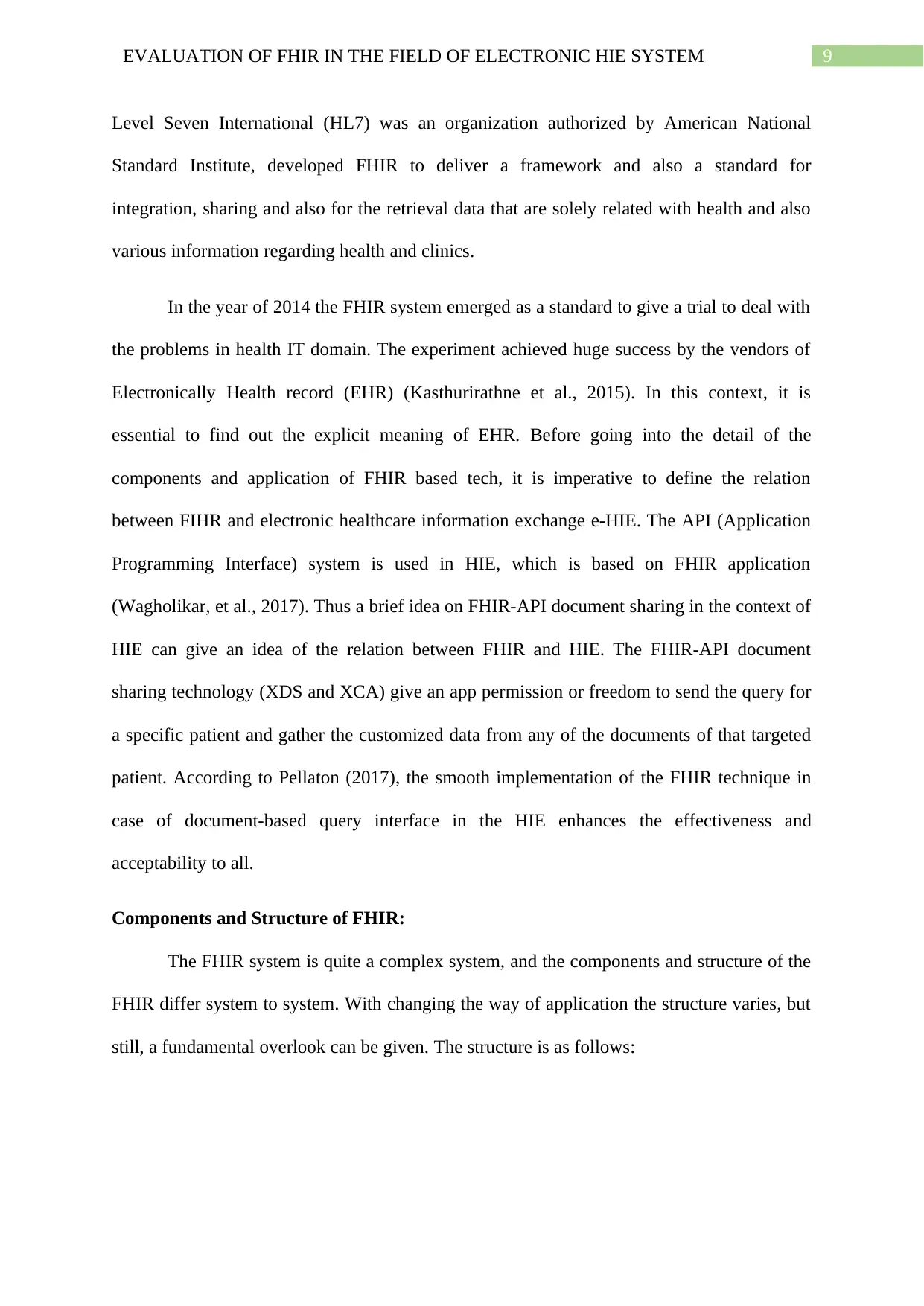
9EVALUATION OF FHIR IN THE FIELD OF ELECTRONIC HIE SYSTEM
Level Seven International (HL7) was an organization authorized by American National
Standard Institute, developed FHIR to deliver a framework and also a standard for
integration, sharing and also for the retrieval data that are solely related with health and also
various information regarding health and clinics.
In the year of 2014 the FHIR system emerged as a standard to give a trial to deal with
the problems in health IT domain. The experiment achieved huge success by the vendors of
Electronically Health record (EHR) (Kasthurirathne et al., 2015). In this context, it is
essential to find out the explicit meaning of EHR. Before going into the detail of the
components and application of FHIR based tech, it is imperative to define the relation
between FIHR and electronic healthcare information exchange e-HIE. The API (Application
Programming Interface) system is used in HIE, which is based on FHIR application
(Wagholikar, et al., 2017). Thus a brief idea on FHIR-API document sharing in the context of
HIE can give an idea of the relation between FHIR and HIE. The FHIR-API document
sharing technology (XDS and XCA) give an app permission or freedom to send the query for
a specific patient and gather the customized data from any of the documents of that targeted
patient. According to Pellaton (2017), the smooth implementation of the FHIR technique in
case of document-based query interface in the HIE enhances the effectiveness and
acceptability to all.
Components and Structure of FHIR:
The FHIR system is quite a complex system, and the components and structure of the
FHIR differ system to system. With changing the way of application the structure varies, but
still, a fundamental overlook can be given. The structure is as follows:
Level Seven International (HL7) was an organization authorized by American National
Standard Institute, developed FHIR to deliver a framework and also a standard for
integration, sharing and also for the retrieval data that are solely related with health and also
various information regarding health and clinics.
In the year of 2014 the FHIR system emerged as a standard to give a trial to deal with
the problems in health IT domain. The experiment achieved huge success by the vendors of
Electronically Health record (EHR) (Kasthurirathne et al., 2015). In this context, it is
essential to find out the explicit meaning of EHR. Before going into the detail of the
components and application of FHIR based tech, it is imperative to define the relation
between FIHR and electronic healthcare information exchange e-HIE. The API (Application
Programming Interface) system is used in HIE, which is based on FHIR application
(Wagholikar, et al., 2017). Thus a brief idea on FHIR-API document sharing in the context of
HIE can give an idea of the relation between FHIR and HIE. The FHIR-API document
sharing technology (XDS and XCA) give an app permission or freedom to send the query for
a specific patient and gather the customized data from any of the documents of that targeted
patient. According to Pellaton (2017), the smooth implementation of the FHIR technique in
case of document-based query interface in the HIE enhances the effectiveness and
acceptability to all.
Components and Structure of FHIR:
The FHIR system is quite a complex system, and the components and structure of the
FHIR differ system to system. With changing the way of application the structure varies, but
still, a fundamental overlook can be given. The structure is as follows:
Paraphrase This Document
Need a fresh take? Get an instant paraphrase of this document with our AI Paraphraser
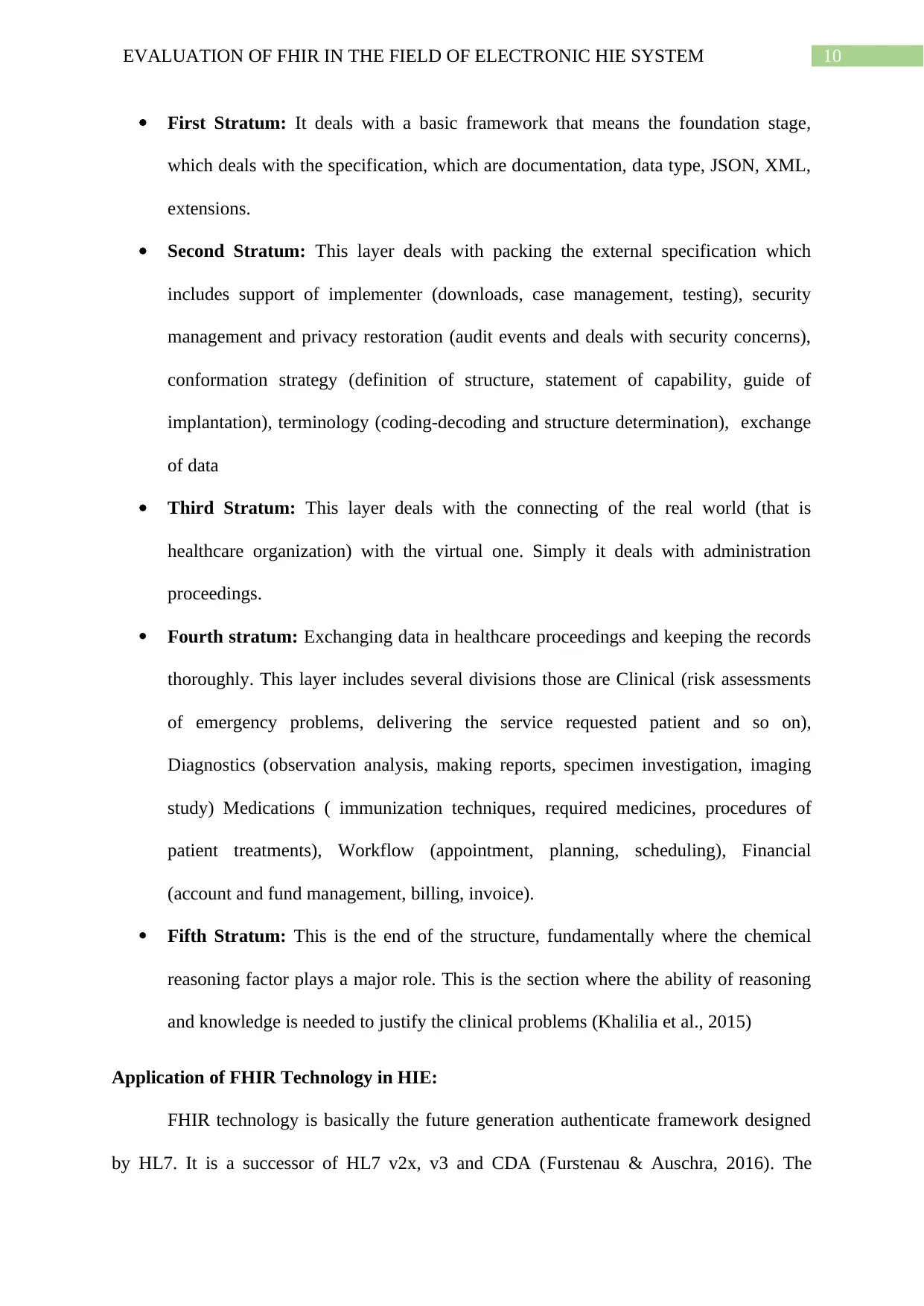
10EVALUATION OF FHIR IN THE FIELD OF ELECTRONIC HIE SYSTEM
First Stratum: It deals with a basic framework that means the foundation stage,
which deals with the specification, which are documentation, data type, JSON, XML,
extensions.
Second Stratum: This layer deals with packing the external specification which
includes support of implementer (downloads, case management, testing), security
management and privacy restoration (audit events and deals with security concerns),
conformation strategy (definition of structure, statement of capability, guide of
implantation), terminology (coding-decoding and structure determination), exchange
of data
Third Stratum: This layer deals with the connecting of the real world (that is
healthcare organization) with the virtual one. Simply it deals with administration
proceedings.
Fourth stratum: Exchanging data in healthcare proceedings and keeping the records
thoroughly. This layer includes several divisions those are Clinical (risk assessments
of emergency problems, delivering the service requested patient and so on),
Diagnostics (observation analysis, making reports, specimen investigation, imaging
study) Medications ( immunization techniques, required medicines, procedures of
patient treatments), Workflow (appointment, planning, scheduling), Financial
(account and fund management, billing, invoice).
Fifth Stratum: This is the end of the structure, fundamentally where the chemical
reasoning factor plays a major role. This is the section where the ability of reasoning
and knowledge is needed to justify the clinical problems (Khalilia et al., 2015)
Application of FHIR Technology in HIE:
FHIR technology is basically the future generation authenticate framework designed
by HL7. It is a successor of HL7 v2x, v3 and CDA (Furstenau & Auschra, 2016). The
First Stratum: It deals with a basic framework that means the foundation stage,
which deals with the specification, which are documentation, data type, JSON, XML,
extensions.
Second Stratum: This layer deals with packing the external specification which
includes support of implementer (downloads, case management, testing), security
management and privacy restoration (audit events and deals with security concerns),
conformation strategy (definition of structure, statement of capability, guide of
implantation), terminology (coding-decoding and structure determination), exchange
of data
Third Stratum: This layer deals with the connecting of the real world (that is
healthcare organization) with the virtual one. Simply it deals with administration
proceedings.
Fourth stratum: Exchanging data in healthcare proceedings and keeping the records
thoroughly. This layer includes several divisions those are Clinical (risk assessments
of emergency problems, delivering the service requested patient and so on),
Diagnostics (observation analysis, making reports, specimen investigation, imaging
study) Medications ( immunization techniques, required medicines, procedures of
patient treatments), Workflow (appointment, planning, scheduling), Financial
(account and fund management, billing, invoice).
Fifth Stratum: This is the end of the structure, fundamentally where the chemical
reasoning factor plays a major role. This is the section where the ability of reasoning
and knowledge is needed to justify the clinical problems (Khalilia et al., 2015)
Application of FHIR Technology in HIE:
FHIR technology is basically the future generation authenticate framework designed
by HL7. It is a successor of HL7 v2x, v3 and CDA (Furstenau & Auschra, 2016). The
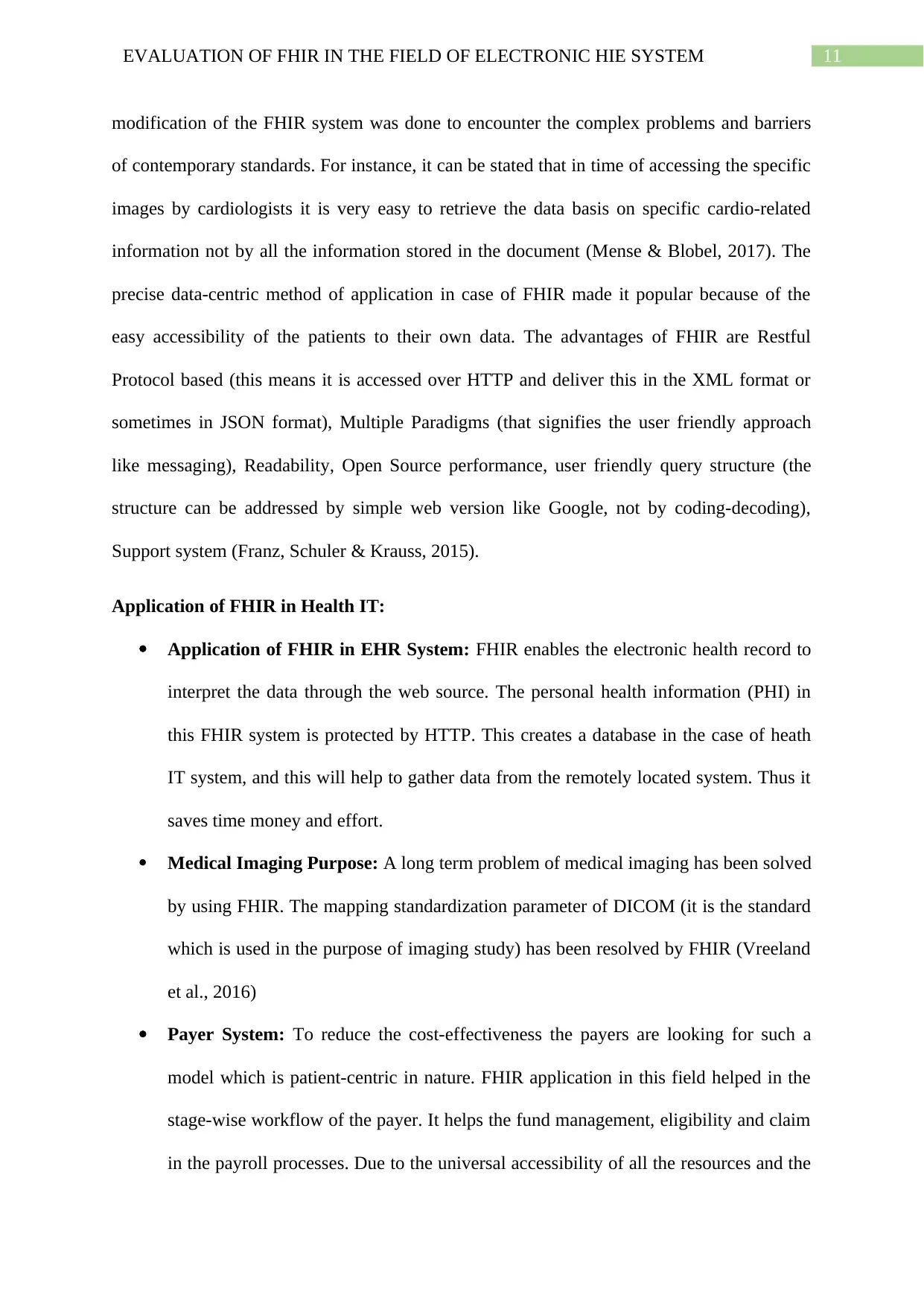
11EVALUATION OF FHIR IN THE FIELD OF ELECTRONIC HIE SYSTEM
modification of the FHIR system was done to encounter the complex problems and barriers
of contemporary standards. For instance, it can be stated that in time of accessing the specific
images by cardiologists it is very easy to retrieve the data basis on specific cardio-related
information not by all the information stored in the document (Mense & Blobel, 2017). The
precise data-centric method of application in case of FHIR made it popular because of the
easy accessibility of the patients to their own data. The advantages of FHIR are Restful
Protocol based (this means it is accessed over HTTP and deliver this in the XML format or
sometimes in JSON format), Multiple Paradigms (that signifies the user friendly approach
like messaging), Readability, Open Source performance, user friendly query structure (the
structure can be addressed by simple web version like Google, not by coding-decoding),
Support system (Franz, Schuler & Krauss, 2015).
Application of FHIR in Health IT:
Application of FHIR in EHR System: FHIR enables the electronic health record to
interpret the data through the web source. The personal health information (PHI) in
this FHIR system is protected by HTTP. This creates a database in the case of heath
IT system, and this will help to gather data from the remotely located system. Thus it
saves time money and effort.
Medical Imaging Purpose: A long term problem of medical imaging has been solved
by using FHIR. The mapping standardization parameter of DICOM (it is the standard
which is used in the purpose of imaging study) has been resolved by FHIR (Vreeland
et al., 2016)
Payer System: To reduce the cost-effectiveness the payers are looking for such a
model which is patient-centric in nature. FHIR application in this field helped in the
stage-wise workflow of the payer. It helps the fund management, eligibility and claim
in the payroll processes. Due to the universal accessibility of all the resources and the
modification of the FHIR system was done to encounter the complex problems and barriers
of contemporary standards. For instance, it can be stated that in time of accessing the specific
images by cardiologists it is very easy to retrieve the data basis on specific cardio-related
information not by all the information stored in the document (Mense & Blobel, 2017). The
precise data-centric method of application in case of FHIR made it popular because of the
easy accessibility of the patients to their own data. The advantages of FHIR are Restful
Protocol based (this means it is accessed over HTTP and deliver this in the XML format or
sometimes in JSON format), Multiple Paradigms (that signifies the user friendly approach
like messaging), Readability, Open Source performance, user friendly query structure (the
structure can be addressed by simple web version like Google, not by coding-decoding),
Support system (Franz, Schuler & Krauss, 2015).
Application of FHIR in Health IT:
Application of FHIR in EHR System: FHIR enables the electronic health record to
interpret the data through the web source. The personal health information (PHI) in
this FHIR system is protected by HTTP. This creates a database in the case of heath
IT system, and this will help to gather data from the remotely located system. Thus it
saves time money and effort.
Medical Imaging Purpose: A long term problem of medical imaging has been solved
by using FHIR. The mapping standardization parameter of DICOM (it is the standard
which is used in the purpose of imaging study) has been resolved by FHIR (Vreeland
et al., 2016)
Payer System: To reduce the cost-effectiveness the payers are looking for such a
model which is patient-centric in nature. FHIR application in this field helped in the
stage-wise workflow of the payer. It helps the fund management, eligibility and claim
in the payroll processes. Due to the universal accessibility of all the resources and the
⊘ This is a preview!⊘
Do you want full access?
Subscribe today to unlock all pages.

Trusted by 1+ million students worldwide
1 out of 22
Related Documents
Your All-in-One AI-Powered Toolkit for Academic Success.
+13062052269
info@desklib.com
Available 24*7 on WhatsApp / Email
![[object Object]](/_next/static/media/star-bottom.7253800d.svg)
Unlock your academic potential
Copyright © 2020–2025 A2Z Services. All Rights Reserved. Developed and managed by ZUCOL.





